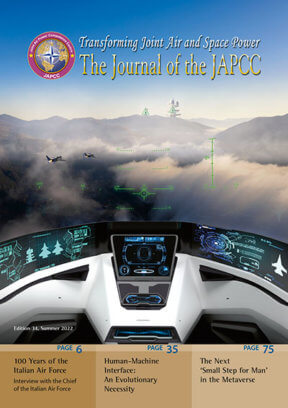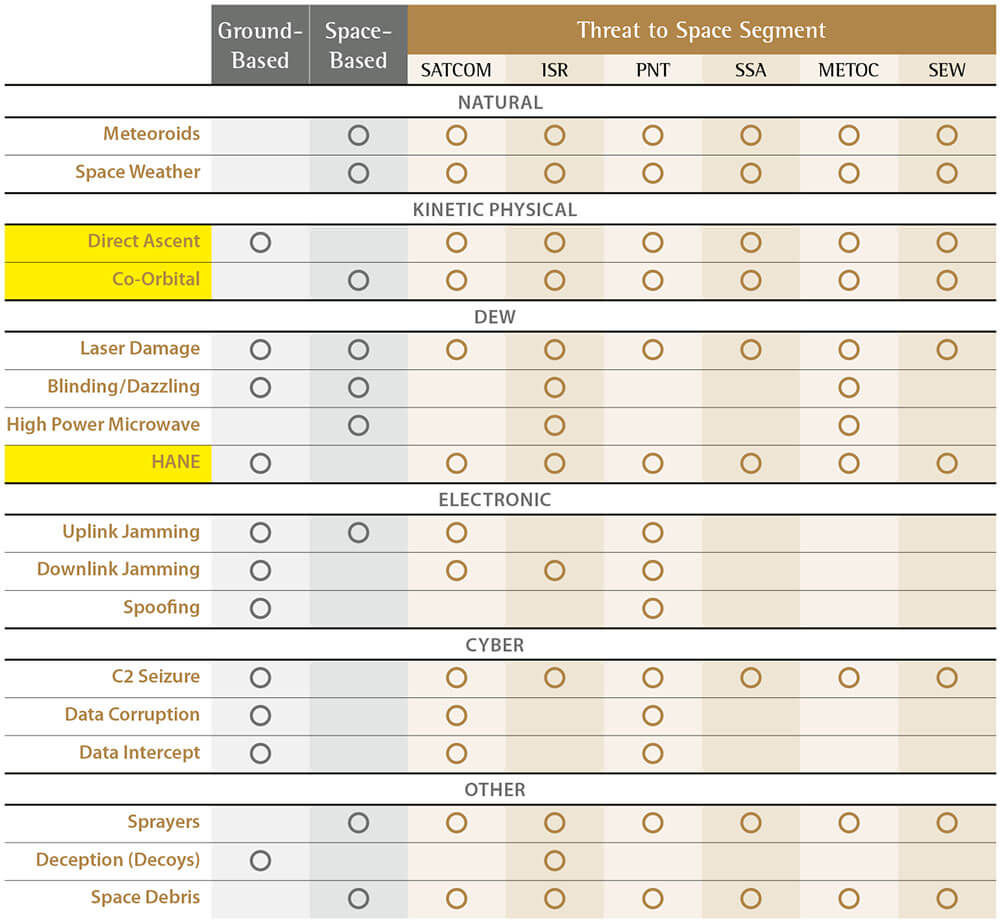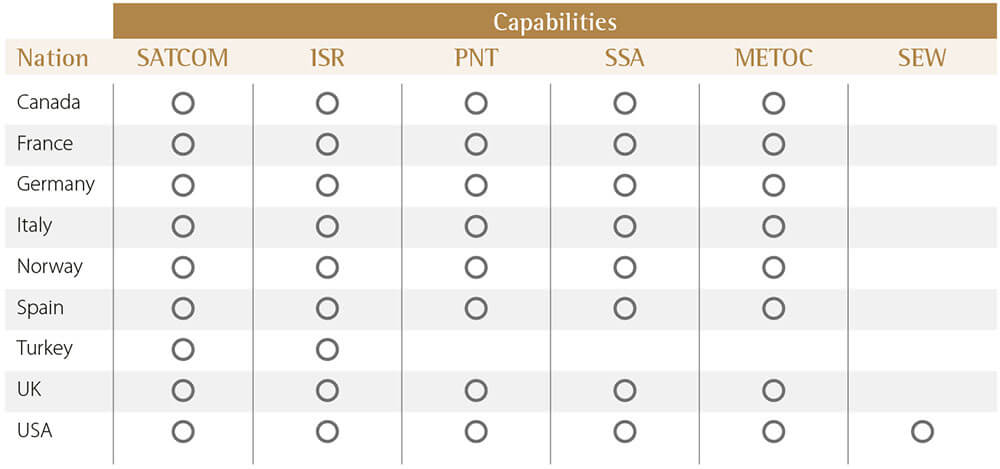Introduction
Space is fundamental for contemporary national security missions. NATO perceived the significance of Space in military operations and for national security by formally designating Space to be an operational domain in December 2019. As the world’s biggest security alliance, NATO relies on Space for a wide range of activities from intelligence gathering and navigation to tracking forces around the globe and detecting missile launches.1
The Space domain is becoming increasingly congested with new non-state actors and corporations constantly joining the race. This domain is incredibly dynamic, sparking new discussions2 on regulating commercial, military, and technological activities in outer space.
The security of space assets will have a defining impact on future terrestrial conflicts. Therefore, defending the final frontier has become a primary concern for NATO. The number of orbiting satellites and satellite mega-constellations is augmenting the Alliance’s capabilities and serves a vital role in the Alliance’s economic interests.
Bearing in mind the founding principles of NATO,3 this article will discuss the threats that the Space domain faces today. It will also outline the potential forms an attack in Space could take and the avenues NATO has to respond to such an event.
Military innovation advancements call for the improvement of extant or development of new concepts of operation and military approaches, primarily aiming to gain asymmetric advantages against potential adversaries. The Alliance is constantly adapting to new threats and, today, Space is a new frontier for defence.
Alliance’s decision to declare Space a new operational domain can be considered a recognition that Space is no longer a peaceful domain. Although NATO diplomats denied that the Alliance could be in a war expanding to Space, declaring Space a domain initiated debates on NATO’s eventual use of space weapons to defend against enemy missiles or to destroy satellites.
The circumstances mentioned below are the sine qua non of NATO’s role in the extraterrestrial environment:
- NATO does not own or operate any space assets in orbit, but is reliant on its member nations to utilize national assets to manage operations and defend Space.
- Not every nation has direct access to Space or for some it is very limited. For example, the United States (US), Germany, France, and Italy have multiple assets in space and could potentially respond in the event of an attack in space. Other nations’ access to space is limited and would likely look for Alliance’s support to respond if their access to space is threatened.
- NATO believes in the peaceful use of Space, and is not developing counter-space capabilities.
Dealing with the 5th Domain Threats
Space is an extraterrestrial global domain where any created effect can have terrestrial consequences. A conflict in orbit could threaten or compromise space assets and access to space services. Therefore, the range of technologies developed and tested as weapons in space by various countries create political, humanitarian, or military concerns. Although the 1967 Outer Space Treaty defines the use of space for peaceful purposes,4 space has been used by militaries since Sputnik for the same reason: security.
Today more than 4,000 active satellites are orbiting the Earth and over half of these are operated by NATO countries to provide a wide range of services like the mobile phone industry, banking system, weather forecast, Global Positioning System, communication, intelligence sharing, and the detection of missile launches. Any threat targeting space assets may impact national and Euro-Atlantic prosperity, security, and stability and could challenge NATO as any terrestrial conventional attack.
In response to a crisis, NATO will operate in areas that require space capabilities wherever terrestrial logistics are not available. Therefore, NATO and its member nations recognize that Space is a domain that must be utilized to succeed in current and future operations. Any potential adversary may quickly note the advantages that Space offers to the Alliance and consequently space systems are becoming high-priority targets.
The increasing potential threats to the Space domain must be considered from a broader perspective. Can Intelligence, Surveillance and Reconnaissance (ISR), Position, Navigation and Timing (PNT), or communication satellites be regarded as weapons? They are not weapons. Nevertheless, due to their contribution to military activity, they could be considered military targets by potential adversaries. For instance, they can be used to attack other satellites by being positioned too close or colliding, thus affecting other on-orbit satellites and causing international unrest.
The risks for the space systems include any threats that can impact the system’s control, reliability, bandwidth availability, security, flexibility, or affordability. These threats can be unintentional (natural hazards or man-made debris) or intentional (Directed Energy Weapons (DEW), electronic, cyber, or kinetic attacks).5
All the threats listed in Figure 1 can limit or degrade a nation’s ability to operate its space capabilities. However, three of the threats can cause a catastrophic loss of capabilities and are the most likely to form the basis for a discussion leading to an Article 5 declaration. Hence, these three critical threats (yellow highlighted) will be the focus of this article.
Figure 1. An overview of the possible effects of space threats over functional space areas.6
Kinetic physical is described as the attempt to physically damage a satellite by a direct strike, detonating a warhead near it, or incapacitating a relevant ground station. Weapons that target the satellites in orbit are known as Anti-Satellite (ASAT) weapons.
- Direct Ascent Anti-Satellite (DA-ASAT): This type of ASAT weapon has been tested by China since 20077 and most recently by Russia in 20218 against their defunct satellites as a demonstration of capabilities. It is especially dangerous because it produces a debris cloud that increases the possibility of future satellite collisions.
- Co-Orbital ASAT: This counter-space capability is an attractive alternative to the DA-ASAT as it limits the resulting debris and it can be challenging to determine the intent of the possible threatening satellite. A Co-Orbital satellite can be utilized in all orbits and can cause a range of effects, from disruption to total loss of capability.
A High Altitude Nuclear Explosion (HANE) is the most detrimental of all potential attacks as it can eliminate all space capabilities in a particular orbit. This form of attack will impact all space capabilities irrespective of ownership, including those owned by the attacker, and therefore it is primarily considered a last resort attack.
Potential NATO adversaries have and are in the process of developing the full suite of counter-space capabilities. In the event of an attack in the Space domain, NATO must be prepared to respond, given that Space is one of its critical domains.
Article 5, the Cornerstone of the Treaty
In case of an attack, the North Atlantic Council could and would invoke Article 5 and take the necessary measures.
NATO’s essential and enduring purpose is to safeguard the freedom and security of all its members using political and military means. Collective defence is at the heart of the Alliance and creates a spirit of solidarity and cohesion among its members.9 As stated in the original manuscript:
‘The Parties agree that an armed attack against one or more of them in Europe or North America shall be considered an attack against them all and consequently they agree that, if such an armed attack occurs, each of them, in exercise of the right of individual or collective self-defence recognised by Article 51 of the Charter of the United Nations, will assist the Party or Parties so attacked by taking forthwith, individually and in concert with the other Parties, such action as it deems necessary, including the use of armed force, to restore and maintain the security of the North Atlantic area.
Any such armed attack and all measures taken as a result thereof shall immediately be reported to the Security Council. Such measures shall be terminated when the Security Council has taken the measures necessary to restore and maintain international peace and security.’10
This article is complemented by Article 6, which stipulates:
‘For the purpose of Article 5, an armed attack on one or more of the Parties is deemed to include an armed attack:
- on the territory of any of the Parties in Europe or North America, on the Algerian Departments of France, on the territory of Turkey or on the Islands under the jurisdiction of any of the Parties in the North Atlantic area north of the Tropic of Cancer;
- on the forces, vessels, or aircraft of any of the Parties, when in or over these territories or any other area in Europe in which occupation forces of any of the Parties were stationed on the date when the Treaty entered into force or the Mediterranean Sea or the North Atlantic area north of the Tropic of Cancer.’11
Space-Capable NATO Nations
In June 2021, NATO declared that ‘The Alliance is not aiming to develop space capabilities of its own and will continue to rely on national space assets. NATO’s approach to space will remain fully in line with international law’.12 NATO has no intention to put weapons in space.
NATO’s in-orbit dependence on partners is clear and finding the perfect balance between national security needs and Article 5 requirements is paramount. Since Allies retain full command and control over their assets, regardless of the particular situations, when there is a conflict of interest between national and organizational priorities, parties should understand and properly prioritize the need from a global perspective, thus truly manifesting the strength of the Alliance.
National space support to NATO cuts across the full spectrum of Space functional areas. Currently, twenty NATO nations own operational satellites. However, Figure 2 lists only those space capabilities owned by the leading Space-capable nations.13
Figure 2. Space systems owned by the main Space-capable NATO nations.14
‘Unus pro omnibus, omnes pro uno’ in Space.
In addition to the capabilities listed in Figure 2, the US also provides Shared Early Warning (SEW) to NATO. Moreover, the US provides all spacefaring nations with Space Situational Awareness (SSA) data to enable peaceful and safe operations in space.
In recent years, an increasing number of NATO member nations have stood up specific military Space elements, such as the US Space Force, the United Kingdom Space Command, the French Space Command, the German Space Command, and the Italian Space Command. Moreover, in 2020 the new NATO Space Centre was established to provide operational Space support to NATO, while in 2021 the NATO Military Committee approved the establishment of the NATO Space Centre of Excellence in Toulouse, France.15 Turkey is also endeavouring to establish a Space Command soon and utilize their rising number of space professionals, expand their capabilities with PNT, SSA, and METOC and integrate strategies, objectives, and projects according to their national space policy.
Recommendations
It is relevant to state that Article 6 does not explicitly mention space assets as stipulations of an armed attack. However, at the 2021 Brussels Summit, NATO recognized that attacks to, from, or within Space present a clear challenge to the security of the Alliance and could lead to the invocation of Article 5 of the North Atlantic Treaty. The key term here is could. As there is currently a grey area on what would constitute an attack in Space, consequently leading to an Article 5 declaration, this article proposes one of two solutions.
- Amend Article 6 to include attacks on space assets.
- Add a new article to limit the response to an attack in Space only with a response in the same domain.
The first solution has the downside that it can lead to the activation of responses from all domains to what many would only consider a conflict in the Space domain. The loss of a space capability is assuredly an attack on a nation’s security; however, losing an asset in space is not a loss of life. Therefore, if Article 5 were declared it would be critical to limit the Alliance’s response to only those actions that prevent any domain crossover and reduce the risk of loss of life.
On the other hand, the second solution benefits from the lack of fatalities and prevents conflict escalation. However, limiting the response to the Space domain has its drawbacks, like endangering other in-orbit assets and restraining the use of cyber-domain capabilities.
Conclusion
NATO is fully aware of the fact that Space is essential to coherent Alliance deterrence and defence. Continuous and secure access to space services, products and capabilities is essential for the credibility of the Alliance’s posture, management of that posture, and the conduct of the Alliance’s operations, missions and other activities.16 The US recognizes that Space is a domain that needs to be defended, and NATO should consider adopting the same perspective. There is no doubt that NATO and its allies will proceed in the most appropriate manner. At this point, it may be helpful to keep in mind that time flows faster in the Space environment and that our potential adversaries are watching the successes of the Alliance in the Space domain with an eagle eye from the front row.
‘Nations that cannot protect their skies can never be sure of their future.’
Mustafa Kemal Atatürk















